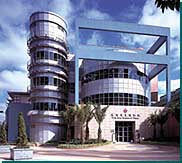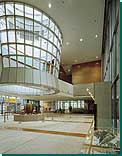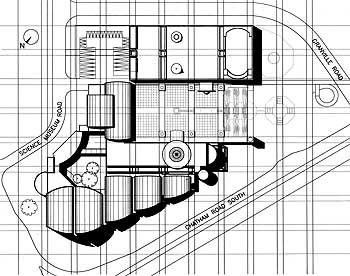| July
2000 |

Hong Kong Museum of History
|
|
|
Hong Kong Museum of History
Cultural
Gridlines
Since the 1970s, a cultural
corridor has been inching its way into the heart of Tsim Sha Tsui.
Starting at the harbour-fronting Cultural Centre, Space Museum and
Museum of Art, it culminates in the Hong Kong Science Museum on
Granville Road. The latest addition to the Urban Council's
footprint of learning
is the Hong Kong Museum of History

main lobby |
The site for the museum is
shared with the Science Museum, completed in 1990 and designed by
P&T Architects and Engineers. In 1994, the firm was appointed
by ASD (Architectural Services Department) as consulting architects
for the adjoining Museum of History. On board for both projects,
P&T worked closely with the Provisional Urban Council-appointed
museum consultant E Verner Johnson and integrated the two projects
into a whole. The development is bounded by roads and linked by
a raised piazza. Acting as a focal point between the projects, the
large open area offers visitors respite from the bustling Tsim Sha
Tsui streetscape before entering the museum of their choice. To
either side, the buildings' designs echo each other inside and out
in a most novel way.
The grid
Unifying the interiors and exteriors of both museums, a planning
grid was used. 18 m x 18 m squares, separated by 4.5-metre service
zones were used throughout both buildings. The service zones in
both buildings are structure-free -- simple flat slabs without beams
or columns -- and allow efficient distribution of staircases, ducts,
and utilities routing. All aligns to a single grid spanning the
entire block, explains P&T Senior Architect Daniel Cheung.
The structural grid helped
in solving service co-ordination problems. For a museum, service
requirements are stringent -- especially for the history museum;
humidity controls, temperature controls, etc, ensure the air ducts
and fittings are very large in size.
Aside from easing the
interior layout and freeing exhibition space from utilities, the
grid formation is expressed on the exterior of each building. On
the Science Museum facade, the grid is recognised in the striped
colour scheme, the columns and the two rectangular rooftop structures.
The history museum's
vaulted roof rises and falls to the same grid lines. The grid carries
to the history museum and repeats in the placement of windows and
structures. To reflect the function inside, the solidity of the
Science Museum facade is replaced by windows and cladding.
A neutral shell
In contrast to the existing building, the Museum of History is more
subdued. Cheung explains: "Because the history museum is next
to the Science Museum, we tried to have something similar to tie
the two buildings together. And of course at the same time, we wanted
it to have something different from the Science Museum. So the Science
Museum is quite a rectangular box -- a rectilinear kind of expression.
But in the history museum we tried to introduce some vaulted roofs,
and to have some wall curves." The result is neutral and unobtrusive,
heightened by the use of ceramic tiles and granite cladding, and
topped by an aluminium corrugated roof. Instead of something alien,
the expression is basically very neutral -- without particular references
to any style -- simultaneously helping to tie the two museums together.
Another significant feature
of both museums is the main piazza. Pedestrian circulation was one
of the original considerations in addressing the site and this is
heightened by the vast open space.
Speaking volumes
Viewed from Chatham Road, the museum none-too-subtly hints at its
cavernous interior. It reflects the volume of the exhibit space
inside as the halls require very high ceilings. The effect is heightened
by the stepped roof. The stepping profile relates to the internal
volume. When one travels inside, you can feel the volume changing.
Along the facade, the grid is once again revealed, albeit somewhat
subtly. "Further toward the Chatham Road side, we kept the
expression of the 18-metre and 4.5-metre spaces, but we tried to
dissolve that in adding the vaulted roof and the curved walls to
give it its own identity," says Cheung.
Underneath the aluminium
roof, the upper reaches of the atria contain service galleries running
the length of the vaults and along the gridlines. Artificial lighting
in the cut-in galleries lights up the vaulted ceiling and is reflected
into the exhibition hall.
Surrounding the museum
is a wide buffer from the busy road, allowing for future road widening,
and helping preserve greenery on the site. Up to 60 per cent of
trees onsite were preserved in the course of construction. The width
of the pedestrian areas on Chatham Road also offers passers-by more
than a fleeting glimpse of the design -- pedestrians can appreciate
the building as they walk along the front of the building.

A journey through time
Visitors enter the four-storey museum's
main lobby beneath a floating inverted cone. Penetrating two levels
above, the glazed cone is the focal point of the area and is a binding
motif from the lobby to the top-floor museum offices. The arrangement
is uncluttered, lined with beech and stainless steel panels, with
stone flooring. Adjoining the lobby is a ticketing counter, a cafe
and the museum shop. As visitors enter from the piazza, they can
look down on the first museum hall through a glass wall rising 13
metres. Tickets in hand, patrons then descend via escalator into
the halls.
Starting on the ground
floor, museum visitors begin their journey through Hong Kong's
rich history. The
ground floor covers a timeline from the stone age to colonialism.
The exhibition space is high enough to accommodate full-scale trees
-- to remind visitors that thick forests once covered Hong Kong
-- and other large exhibits. At the end of the first floor exhibits,
visitors reach a resting space and indoor courtyard. The ground
floor receives no natural light, a principle which guided the design
of the resting space. "The exhibit designer wanted to use artificial
light to control the lighting effects, so we thought we needed a
break in the journey through the exhibits. At the end of the ground
floor, we have a resting area, which is a glazed wall overlooking
a courtyard." Featured within the courtyard are trees preserved
onsite, one of the original considerations of the design.
Rested, visitors hop
off the escalator on the second floor exhibition space for a guided
tour through Hong Kong's
colonial past. Again, the size of the halls allows for large-scale
exhibits, including replica colonial architecture and a tram. Ending
their journey among displays of the contemporary Hong Kong, visitors
will find themselves beside a large void. Patrons can peer down
on the exhibition's
starting point below -- directly sampling the earliest artifacts,
albeit at a distance, alongside the new. With their trip complete,
visitors can then descend a floor via escalator to their starting
point, the Main Lobby.
P&T was able to draw
on their experience with the Science Museum in tackling the interiors
and exhibition space. By nature, the Science Museum is not chronological
-- exhibits are linked to a central atrium regardless of sequence.
On the other hand, the Museum of History called for a timeline of
exhibits. Adopting the same structural grid for different purposes
served well, easing the arrangement of exhibition space. The lobby
was shifted close to the entrance with a clearly defined journey
laid from it. When the permanent exhibition areas are fitted-out
by mid-2000, the major exhibits will be more-or-less fixed. Accordingly,
there is a thematic exhibition hall. This is situated at the end
of the piazza, and will be rented out or used for specific exhibitions.
P&T's
Science Museum also
provided cues on planning circulation. "In organising the plans,
the most difficult task we faced was to organise the circulation.
Different groups of people have their own entrance," says Cheung.
A separate entrance with a lecture hall and functions area is found
at the start of the exhibition. The entrance serves not only group
bookings but also doubles as the museum staff entrance. Service
access is crucial, and a large-sized entry is provided from the
museum carpark -- a site for future expansion for both museums.
developer Client department:
Architectural Services Department
User department: Urban Services Department
architects P&T Architects & Engineers Ltd
m&e engineer Meco Engineering Ltd
main contractor Wan Chung Construction Co Ltd
fire services Meco Engineering Ltd
|


